Influence of cascade reservoirs on spatiotemporal variations of hydrogeochemistry in Jinsha River
Qiu-sheng Yuan,Pei-fang Wang,Juan Chen,Chao Wang,Sheng Liu,Xun Wang
Key Laboratory of Integrated Regulation and Resources Development of Shallow Lakes,Ministry of Education,Hohai University,Nanjing 210098,China
Abstract River hydrogeochemistry offers necessary guidance for effective water environmental management.However,the influence of cascade reservoirs on river hydrogeochemistry remains unknown.In this study,the Jinsha River,the headwaters of the Yangtze River of China,was selected to investigate the spatiotemporal variations of hydrogeochemistry after the construction of six cascade reservoirs.Major ions,total dissolved solids,electrical conductivity,and pH values of sampled water in the upper natural reaches and lower reservoir-regulated reaches were analyzed in both flood and dry seasons.The results of Piper diagram and Gibbs plots showed that the hydrogeochemistry of the Jinsha River was naturally controlled by both evaporation-crystallization and carbonate weathering processes,but it was also artificially affected by reservoirs.The impoundment of cascade reservoirs affected the hydrodynamic condition of the river.The river flow in the flood season was reduced by approximately 24.5%,altering the proportions of water sources and leading to notable hydrogeochemical alterations in reservoir-regulated reaches.Conversely,river hydrogeochemistry generally remained unchanged in the dry season,owing to the insignificant effect of cascade reservoirs on river flow.In contrast to what has been observed in previous studies of individual reservoirs,the cumulative influence of cascade reservoirs on the Jinsha River flow regime did not cause abrupt hydrogeochemical changes between the upstream and downstream areas of each reservoir.Moreover,the water quality assessments revealed that the impoundment of cascade reservoirs improved downstream irrigational water quality,with lower Na+ratio values in the flood season.This study provides the earliest evaluation of cascade reservoir influence on the hydrogeochemistry of the Jinsha River.The findings of this study can be used as a reference for scientific guidelines for future environmental management of cascade reservoirs in large rivers.
Keywords:River hydrogeochemistry;Spatiotemporal variations;Controlling factors;Cascade reservoirs;Jinsha River
1.Introduction
Large rivers play a significant and irreplaceable role in the global water cycle and geochemical cycle involving continents and oceans(Immerzeel et al.,2013).Water quality of large rivers is a crucial and sensitive issue worldwide because it is always affected by a variety of natural and artificial factors(Jin et al.,2015,2020;Pant et al.,2018).In general,river hydrogeochemistry is primarily controlled by the evaporationcrystallization,atmospheric precipitation,and rock weathering processes(Gibbs,1970;Martin and Meybeck,1979),and it is secondarily influenced by surface runoff,groundwater discharge,and anthropogenic disturbance(Qu et al.,2019;Wang et al.,2018;Wu et al.,2008).Study of river hydrogeochemistry provides important guidance for water quality management,because it not only enables comprehensive understanding of the composition and characteristics of riverine chemicals,but also offers necessary indicators for aquatic environment protection(Pant et al.,2018).Due to the importance of river hydrogeochemical attributes in water quality management,the chemical signatures and relevant controlling factors of many large rivers worldwide,including the Mekong River(Huang et al.,2009),Yangtze River(Chen et al.,2002),and Amazon River(Stallard and Edmond,1987),have been thoroughly studied.These studies have provided important information on the sources,patterns,and controlling mechanisms of riverine chemicals in global water cycling(Meybeck and Ragu,2012;Viers et al.,2009).
Over the past half century,many cascade reservoirs have been constructed in large rivers for various purposes,including flood control,power generation,navigation,drinking water,and irrigation(Winemiller et al.,2016).However,cascade reservoirs have simultaneously transformed lotic river systems into serial,discontinuous,and slow-flow reservoir systems(Shi et al.,2017),resulting in considerable modification of geomorphology,temperature,and flow regimes,as well as spontaneous cycles of riverine chemicals(Ellis and Jones,2013;Chao et al.,2016).It has been reported that individual reservoirs constructed in large rivers have the potential to significantly alter river hydrogeochemistry,owing to the enrichment of anthropogenic contamination within reservoirs or the erosion of released water in downstream areas of reservoirs(Kelly,2010;Gao et al.,2013;Wang et al.,2018).For example,Wang et al.(2018)found that after the impoundment of the Three Gorges Reservoir in the Yangtze River of China,the concentrations of anions(e.g.,SO24-,Cl-,and NO-3)and cations(e.g.,Ca2+,Mg2+,and Na+)sharply increased because of the modification of hydrological and geochemical processes as well as the mixing patterns of different water sources.In addition,Gao et al.(2013)proposed that the impoundment of the Wujiangdu Reservoir could significantly change riverine chemical weathering,which in turn could modify the river hydrogeochemical composition downstream.Recent studies have only focused on the influence of individual reservoirs.However,the impact of cascade reservoirs is still unknown.The repetitive and accumulative effects of cascade reservoirs on river flow,sediment transport,biogenic substance,and plankton may significantly alter river hydrogeochemistry through the dam blockage,intermittent discharge,and reservoir backwater processes,which differ from the conditions in individual reservoirs(Chen et al.,2020;Huang et al.,2018;Winemiller et al.,2016).It has been demonstrated that cascade reservoirs have cumulative impacts on river hydrodynamic process and flow regime,and their effect is notably greater than those related to individual reservoirs(Huang et al.,2018).For example,Huang et al.(2010)concluded that the cumulative influence of multiple cascade reservoirs on the upper Yangtze River flow regime is stronger than the total impacts of all reservoirs under independent operation.Therefore,it can be hypothesized that cascade reservoirs may produce cumulative effects on river hydrogeochemistry as they cumulatively impact river flow regime.
The Jinsha River is a large river in China that originates on the Qinghai-Tibet Plateau and flows through the arid and semiarid alpine regions.This river is regulated by typical cascade reservoirs(Li et al.,2013).As the headwaters of the Yangtze River,the Jinsha River serves as a vital resource for the downstream drinking water and agricultural irrigation.Owing to the social and economic importance of this river,there is immense concern about its water quality(Yuan et al.,2019).It is therefore essential to investigate the hydrogeochemistry of the Jinsha River,because of its important role in sustaining human livelihood and maintaining ecological balance.Previous studies have investigated the specific signatures of natural and anthropogenic disturbances to the hydrogeochemistry of the Jinsha River(Qu et al.,2015;Wu et al.,2008).However,no published works have focused on the spatial variations of river hydrogeochemistry as influenced by six cascade reservoirs successively put into operation between 2010 and 2014(Li et al.,2018).Recently,the seasonal regime of Jinsha River flow has been significantly affected by the cascade reservoirs,exhibiting a reduced flood-season river flow and an increased dry-season river flow(Huang et al.,2018).However,the way in which the six cascade reservoirs affect river hydrogeochemistry in different seasons remains poorly understood.
This study hypothesized that(1)the operation of cascade reservoirs affects the spatial and seasonal variations of river hydrogeochemistry,and(2)water quality is significantly influenced by cascade reservoirs.To test these hypotheses,the hydrogeochemical composition of the Jinsha River was investigated using water samples from the upper natural reaches and lower reservoir-regulated reaches in both flood and dry seasons.Furthermore,the quality of drinking water was assessed using the World Health Organization guidelines(WHO,2011),and the quality of irrigation water was assessed through the percent sodium(P)and sodium adsorption ratio(R)(Thomas et al.,2014).This study intended to provide an integrated understanding of the influence of cascade reservoirs on the spatiotemporal variations of hydrogeochemistry in the Jinsha River.The findings of this study are expected to contribute to future environmental management of cascade reservoirs in large rivers.
2.Materials and methods
2.1.Study area and field sampling

Fig.1.Sampling sites in natural reaches(N1 through N12)and reservoir-regulated reaches(LY-U/D,AH-U/D,JAQ-U/D,LKK-U/D,LDL-U/D,and GYY-U/D)and lithologic map of Jinsha River Basin extracted from Wu et al.(2008).
The Jinsha River is 2 290 km long,with an average slope of 1.44 m/km and a drainage area of 362 000 km2(Fig.1).The river originates from the Tongtian River,which is located in an arid and cold area with intense evaporation and an annual precipitation below 500 mm.However,the lower Jinsha River region falls within the India Monsoon climate zone and is wetter than the upstream region.The annual precipitation varies significantly with altitude.The upper Jinsha River from the Benzilan to Shigu hydrological stations has an annual precipitation of approximately 600 mm.By contrast,the annual precipitation in the middle and lower reaches from the Huiyi to Yibin stations is 900 to 1 300 mm(Wu et al.,2008).Precipitation and runoff are mainly concentrated from May to October in the flood season,a period that accounts for over 90%of the annual total amount(data source from the Yangtze River Water Resources Commission,http://www.cjw.gov.cn).The lithology of the Jinsha River Basin is complicated(Fig.1).The headwaters arise from the Tanggula and Bayan Har fold belts,which are made up of clastic rocks(ClR)and carbonate rocks(CaR),as well as quaternary fluvial deposits(QFD)entrained with volcanic rocks and evaporite rocks.In the upper reaches,CaR,ClR,ophiolitic m´elanges(OpM),and low-grade metamorphic rocks(LMR)are widely distributed.Moreover,CaR,ClR,QFD,continental basalts,high-grade metamorphic rocks(HMR),and granitoids(Gra)are commonly found in the middle and lower river basin(Wu et al.,2008).Over the past decade,six mega cascade reservoirs were constructed and put into operation in the middle Jinsha River reaches,including the Liyuan(LY),Ahai(AH),Jinanqiao(JAQ),Longkaikou(LKK),Ludila(LDL),and Guanyinyan(GYY)reservoirs(Fig.1).Detailed information on these reservoirs is presented in the supplementary data.In this study,the upstream reaches of the Jinsha River were defined as natural reaches because they maintained their original appearance with negligible influence from human activities.Given that the downstream river was greatly influenced by the cascade reservoirs,it was defined as a regulated reach.The average discharges at the Shigu(upstream of all six reservoirs)and Panzhihua(downstream of all six reservoirs)hydrological stations before(in 2007 and 2008)and after(in 2015 and 2016)the operation of cascade reservoirs are shown in Fig.2.
Considering the potential influence of climate change,water samples were collected in the flood season(May)and the dry season(December)of 2017.All samples were collected in a week without rainfall effects to ensure relatively consistent aquatic conditions.Moreover,most of the sampling areas were in the high mountains,with steep gorges,where various uncertain geological disasters usually occur in the middle and late flood season.Thus,the sampling time was selected to occur in the early flood season(May).The selection of sampling locations was based on the hydro-climatic variations,in terms of altitude,distance,topography,and reservoir sites without the influence of water confluence due to large tributaries.Of the total 24 total sampling sites,12 were in the natural reaches,and 12 were situated across six reservoirs(Fig.1).Detailed information on the locations of these sampling sites is available in the supplementary data.All water samples were collected in the middle of the river channel with 2-L wide mouth polyethylene bottles.The sampling equipment was rinsed with river water twice before sampling.Samples were taken against the river flow direction at a depth of approximately 50 cm.
2.2.Water physicochemical analysis
Water pH and electrical conductivity(Ec)were determined in situ with a calibrated multiparameter water quality analyzer(HQ40d,Hach Co.,USA).Water samples were subsequently filtrated through 0.2-μm millipore nitrocellulose filters(Shanghai Xin Ya Purification Equipment Co.,Ltd.,China).The samples for cation analysis were acidified to pH<2.0 using high-purity HNO3.These filtrated water samples were stored at 4°C for chemical analysis.
Concentrations of major cations,such as Na+,K+,Ca2+,and Mg2+,and dissolved silicon(Si),were measured with an inductively coupled plasma-optical emission spectrometer(ICP-OES,Prodigy,USA).The detection limits of ICP-OES were 0.01μg/L for Si and 0.05μg/L for other elements.Concentrations of major anions,such as SO24-,Cl-,HCO-3,and NO-3,were detected by an ion chromatography system(Dionex ICS-900,Thermo Scientific,USA)with a detection limit of 0.1μg/L.The analysis followed standard operating procedures,with blank reagent as well as duplicate samples,and the analytical error of all major ions was no higher than 3%.For quality control,standard samples of known concentrations were periodically analyzed.The estimates of total dissolved solid concentration(ρ(TDS))were obtained using the following formula(Wu et al.,2008):

2.3.Water quality assessment
Riverine water quality for drinking purposes was assessed by comparing the values of major water quality index values with the standard values from the World Health Organization(WHO,2011).In addition,P and R were used to evaluate the irrigation water quality(Thomas et al.,2014).The estimates of P and R were mathematically expressed as follows:
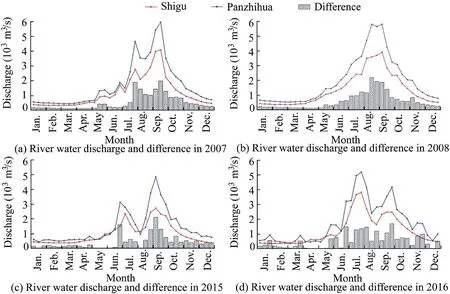
Fig.2.Average discharges at Shigu and Panzhihua hydrological stations and discharge differences before and after operation of cascade reservoirs(data from the Bureau of Hydrology,Ministry of Water Resources of the People's Republic of China).

Detailed information on the standards of irrigation water quality is presented in the supplementary data.
2.4.Data analysis
Descriptive statistical analysis was performed to evaluate the spatiotemporal variation of each variable.The variations in different seasons were compared through paired t-tests for the upper natural reaches,the lower reservoir-regulated reaches,and the entire river.Furthermore,Piper(1944)and Gibbs(1970)plots as well as ionic relationship analysis(Qu et al.,2019)were used to clarify the controlling mechanisms of river hydrogeochemistry.
3.Results and discussion
3.1.General hydrogeochemistry of entire Jinsha River
Table 1 presents the geochemical composition of the Jinsha River in flood and dry seasons.Theρ(TDS)value for the entire Jinsha River water samples(501 mg/L)was five times higher than the average of global rivers,owing to the influence of the arid/semiarid alpine environment in southwestern China,and was similar to the conditions in the upper Mekong River and Yarlung Tsangpo River,as shown in Table 2(Meybeck and Ragu,2012;Qu et al.,2015,2017).
The average concentrations of major cations throughout the Jinsha River could be ranked in the following descending order:ρ(Na+)>ρ(Ca2+)>ρ(Mg2+)>ρ(K+).Na+accounted for 48.79%of the total cation budget of the Jinsha River,followed by Ca2+and Mg2+,accounting for 35.60%and 14.20%,respectively(Table 1).The content of Na+for the entire Jinsha River water was over ten times higher than the global average(Meybeck and Ragu,2012).This is attributed to the predominant influence of intense evaporation at the headwaters(Wu et al.,2008;Qu et al.,2015).Furthermore,the concentrations of Ca2+and Mg2+were three and five times higher than the global averages,respectively.This implies that carbonate weathering was another factor that controlled the variation of hydrogeochemistry along the Jinsha River(Meybeck,2003).
The average concentrations of major anions followed the pattern ofρ(HCO-3)>ρ(Cl-)>ρ(SO2-4)>ρ(NO-3)(Table 1).These results are consistent with previous findings,and it was determined that intense rock weathering and evaporite dissolution were responsible for the relatively higher concentrations of HCO-3,Cl-,and SO2-4than those of global averages(Meybeck,2003).The silicate weathering was relatively less intense in the Jinsha River,and the average dissolved silica concentration(3.41 mg/L)was lower than the average of global rivers(Meybeck,2003).Compared to the aforementioned geochemical processes,silicate weathering was less pronounced(Pant et al.,2018).These findings are similar to those of previous studies on the Jinsha River and surroundingrivers in southwestern China(Wu et al.,2008;Huang et al.,2009;Qu et al.,2015,2017).

Table 1 Geochemical composition of Jinsha River in flood and dry seasons.

Table 2 Geochemical composition of Jinsha River and surrounding large rivers in China.
3.2.Influence of natural processes on river hydrogeochemistry
3.2.1.pH,total dissolved solids,and electrical conductivity
The Jinsha River Basin is carbonate-dominated,leading to a mildly alkaline river water condition with a pH value ranging from 7.85 to 9.43(Fig.3 and supplementary data).Due to the effect of surface runoff,the pH value increases along the Jinsha River(Wu et al.,2008;Qu et al.,2015).The paired ttest between the pH values in different seasons revealed that the pH value in the dry season was 0.28 higher than that in the flood season(p<0.05)(see supplementary data).This was probably due to the strong riverine microbial respiration(high air temperature)in summer and the lesser influence of acid rain(low precipitation)in winter(see supplementary data).
The upper natural reaches of the Jinsha River were characterized by notably higherρ(TDS)and Ecvalues and greater spatial variation than in the lower reservoir-regulated reaches.The highestρ(TDS)and Ecvalues were observed at the headwaters of the Jinsha River(sample N1),and the lowest values were recorded at the AH reservoir(sample AH-D)(Fig.3 and supplementary data).The higherρ(TDS)and Ecvalues in the upper Jinsha River were due to intense evaporation that significantly exceeds precipitation.They were also caused by excessive hydraulic erosion and chemical weathering in the arid/semiarid alpine environment.Moreover,the substantially increased river flow and precipitation along the Jinsha River Basin played a pivotal role in diluting the ionic concentration(Fig.2 and supplementary data).Simultaneously,the degree of hydraulic erosion and chemical weathering was reduced,owing to the increased river flow and widened river channel.The relatively low concentration of suspended solids in downstream areas indirectly reduced the CaR dissolution(Chen et al.,2002).Thus,theρ(TDS)value tended to decrease along the Jinsha River(Fig.3).However,theρ(TDS)and Ecvalues of sample N2 in the dry season were abnormally lower than those of surrounding sampling sites.Glaciers were observed in most areas of the upstream region,located in a valley with an elevation higher than 3 000 m(see supplementary data).As reported in a previous study on hydrogeochemistry of the Gandaki River,the dilution of glacier meltwater may potentially decrease ionic concentrations(Pant et al.,2018).
The seasonal variations ofρ(TDS)and Ecbetween the upper natural reaches and lower regulated reaches of the Jinsha River were significantly different(p<0.05)(see supplementary data).In the flood season,higherρ(TDS)and Ecvalues in the upper natural reaches were closely correlated with the strong evaporation-crystallization processes(high air temperature in May)(see supplementary data).The significantly increased river flow and precipitation in the flood season may decreaseρ(TDS)and Ecthrough the dilution effect(see supplementary data),but they played a less important role than the effect of evaporation processes.However,these natural phenomena suddenly disappeared in the lower reaches because of the effect of cascade reservoirs.This issue is discussed in section 3.3.
3.2.2.Concentrations of major ions
Concentrations of major ions exhibited a decreasing trend along the Jinsha River except those of Si and NO-3.This is consistent with previous findings on the spatial variations of ρ(TDS)and Ec.The Si and NO-3concentrations were relatively lower than those of other chemicals,and they were fairly consistent along the entire river(Fig.3 and supplementary data).Several elevated NO-3concentrations were recorded in the lower reservoir-regulated reaches,such as the downstream area of the LKK Reservoir and upstream area of the GYY Reservoir.This was due to the anthropogenic nitrogenous fertilizer contamination from riparian agriculture drainage in the dry-hot valley of the Jinsha River(Pant et al.,2018;Zhang et al.,2006).Most ionic concentrations in the lower Jinsha River were less than half of those in the upper reaches,whereas the river flow was almost doubled downstream(Figs.2 and 3).Due to the rain shadow climate and intense evaporate dissolution caused by high solar radiation in the upper arid/semiarid alpine regions,the Na+and Clconcentrations in the upstream region were much higher than those in the downstream region(Qu et al.,2015,2019).In addition,water recharge from the surrounding saline lakes and hot springs also contributed to the elevated Na+and Clconcentrations(Qu et al.,2019).
In the flood season,the water ionic concentration changed from the patterns ofρ(Na+)>ρ(Ca2+)>ρ(Mg2+)>ρ(K+)andρ(Cl-)>ρ(HCO-3)>ρ(SO2-4)>ρ(NO-3)in the upstream region to the patterns ofρ(Ca2+)>ρ(Na+)>ρ(Mg2+)>ρ(K+)andρ(HCO-3)>ρ(SO2-4)>ρ(Cl-)>ρ(NO-3)in the downstream region.However,the ionic abundance of river water in the dry season followed the unchanged patterns of ρ(Na+)>ρ(Ca2+)>ρ(Mg2+)>ρ(K+)andρ(HCO-3)>along the entire Jinsha River(Fig.3 and supplementary data).As mentioned earlier,the Jinsha River Basin is CaR-dominated,and therefore,the concentration of HCO-3was the highest among all anions(Wu et al.,2008).Although river water with elevated Cl-concentrations discharged from the headwaters,surface runoff from the CaR-dominated lithology increased the downstream HCO-3concentrations.The coupled effect of high precipitation and intense surface runoff resulted in the high river flow in the flood season.This was responsible for the lower concentrations of Na+,K+,Cl-,,andand the higher concentrations of Ca2+and HCO-3along the Jinsha River in the flood season than in the dry season.
The spatial and seasonal variations of major ions demonstrated that the hydrogeochemistry of the Jinsha River was mainly controlled by natural processes according to different climate,geology,and hydrology.However,the variation patterns of these hydrogeochemical processes in upper natural reaches were not similar to those in lower reservoir-regulated reaches,where river flow regime was influenced after the operation of cascade reservoirs(Huang et al.,2018).
3.3.Impact of cascade reservoirs on river hydrogeochemistry
3.3.1.Comparison of natural and reservoir-regulated conditions
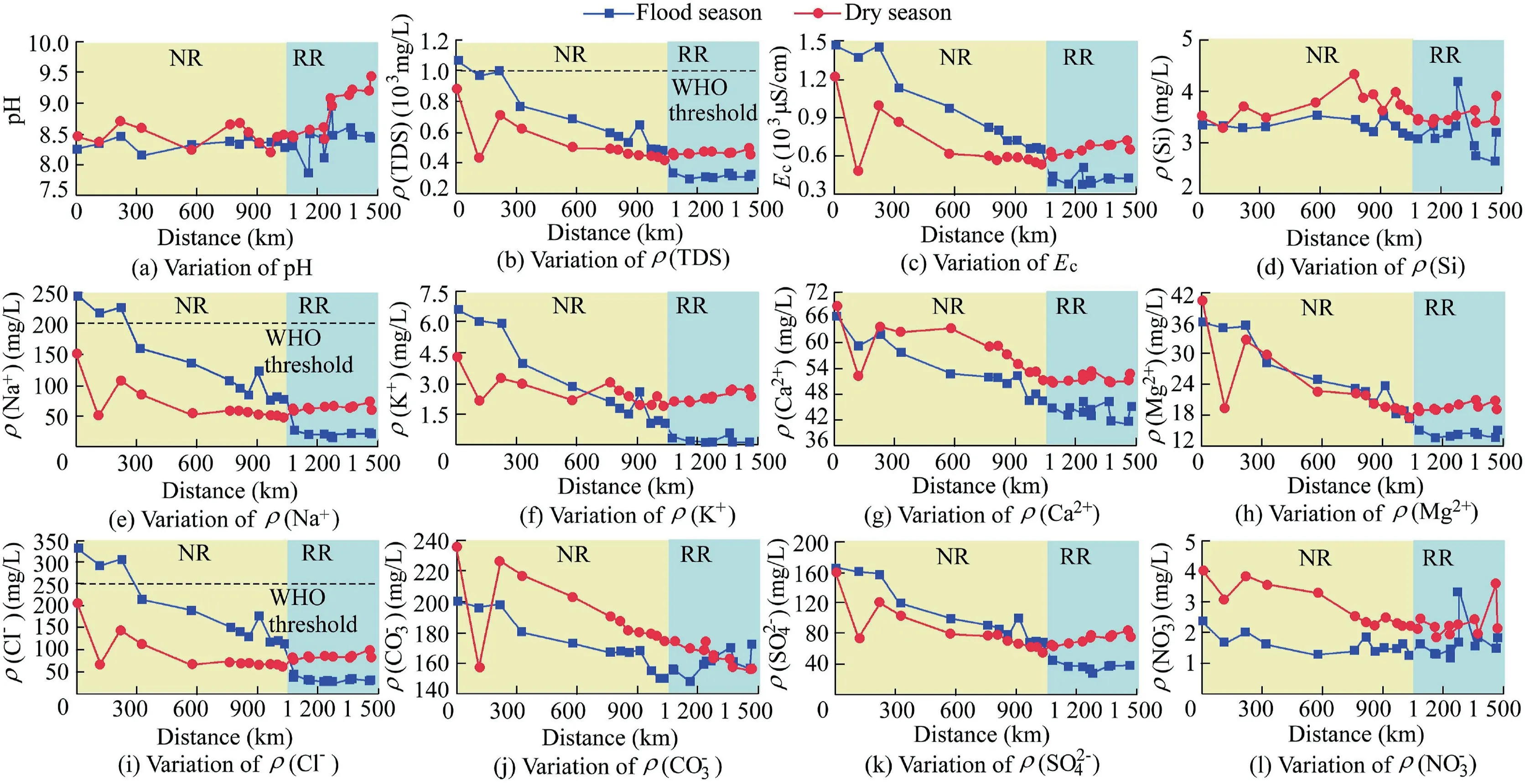
Fig.3.Spatiotemporal variations of hydrogeochemistry in upper natural reaches(NR)and lower reservoir-regulated reaches(RR)of Jinsha River.
Fig.4 shows the hydrogeochemistry at the Shigu(upstream area of all six reservoirs)and Panzhihua(downstream area of all six reservoirs)hydrological stations in flood and dry seasons for the time periods before(in 2005)and after the operation of cascade reservoirs(in 2017).In the figure,F-2005 and D-2005 represent the flood and dry seasons in 2005,respectively,and F-2017 and D-2017 represent the flood and dry seasons in 2017,respectively.Data for 2005 were from Wu et al.(2008)and data for 2017 were from this study.The change rate of ionic concentrations between Shigu and Panzhihua hydrological stations was used to investigate the influence of cascade reservoirs on river hydrogeochemistry.
After the construction of cascade reservoirs,the concentration change rates of Na+,K+,and Cl-were largely altered in the flood season,from-41.4%to-18.9%in 2005 to-85.8%to-72.7%in 2017,whereas the change rates for these chemicals in the dry season increased from-63.6%to-23.2%in 2005 to 16.5%to 26.7%in 2017(Fig.4).This phenomenon shows a remarkable difference from the conditions before the construction of cascade reservoirs as reported in Wu et al.(2008).Furthermore,the change rates of HCO-3concentration increased in the flood season and decreased in the dry season under the cascade reservoir regulations(Fig.4).In addition to the effects of reservoirs,human activities also induced the changes of ionic concentrations.Abnormally high concentrations ofin the Panzhihua region were largely ascribed to the effect of coal consumption in Sichuan Province(Chen et al.,2002;Wu et al.,2008),where heavy metal pollution is also severe,as reported in previous studies(Yuan et al.,2019,2021).Meanwhile,the concentrations of NO-3were notably increased in both the Shigu and Panzhihua areas after the construction of reservoirs(from 0.20 to 0.90 mg/L in 2005 to 1.47 to 2.28 mg/L in 2017)because of the growing impact of agricultural nitrogenous fertilizers(Zhang et al.,2006).The population density in the lower reservoirregulated reaches is over 100 per km2higher than in the upper natural reaches,and the Sichuan Basin is a large ricefarming center(Wu et al.,2008).Therefore,the change rates of SO42-and NO-3cannot accurately reflect the impacts of cascade reservoirs,and they were much more significantly influenced by other anthropogenic activities.
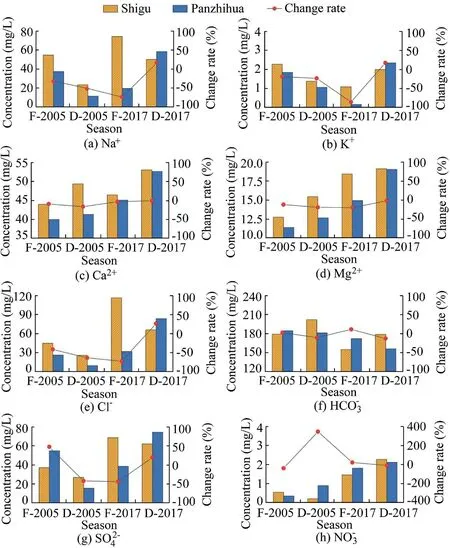
Fig.4.Hydrogeochemistry of ionic concentrations at Shigu and Panzhihua hydrological stations and change rates of ionic concentrations between these two stations in flood and dry seasons before(in 2005)and after(in 2017)operation of cascade reservoirs.
Cascade reservoirs limit the natural transfer of river water,decrease the longitudinal velocity of water flow,and thus facilitate seasonal variations of river flow(Huang et al.,2018;Li et al.,2018;Chao et al.,2016;Wang et al.,2018).Due to the construction of cascade reservoirs along the Jinsha River,the monthly river flow regimes also significantly changed,causing reduced river flow in the flood season and increased river flow in the dry season(Huang et al.,2018).Before the operation of cascade reservoirs(2007-2008),the variation of the Jinsha River flow ranged from(800.48±60.05)m3/s at the Shigu hydrological station to(1 223.14±139)m3/s at the Panzhihua hydrological station in May.However,after the operation of cascade reservoirs(2015-2016),the variation of the river flux changed from(785.33±23.14)m3/s at the Shigu hydrological station to(849.36±182.12)m3/s at the Panzhihua hydrological station.The river flow at the Shigu hydrological station showed no significant alteration.By contrast,the river flow at the Panzhihua hydrological station was notably reduced by approximately 24.5%in the flood season,as calculated based on the average discharge data in May before and after the operation of reservoirs(Fig.2).This further altered river hydrogeochemistry.In the flood season,river water supplied from the upper reaches and additionally added water from tributaries converged and was partially trapped within reservoirs.Therefore,the concentrations of Na+and Cl-were abruptly diluted to one third of their original contents. However, the HCO-3concentration increased,which may have been due to the effect of surface runoff from the CaR-dominated lithology(Wang et al.,2018).Conversely,in the dry season,river hydrogeochemistry was more significantly influenced by the upstream water,owing to the slight river flow increase of approximately 1.1%,regulated by the cascade reservoirs(Fig.2).Therefore,major ionic compositions were relatively consistent from the upper natural reaches to the lower reservoir-regulated reaches.In addition,the arid and cold climate drastically reduced the amount of water supplied from tributaries along the Jinsha River Basin in the dry season(Wu et al.,2008).
3.3.2.Comparison between upstream and downstream regions of each reservoir
The major ionic concentrations showed no abrupt changes between the upstream and downstream regions of each reservoir along the Jinsha River,except K+in the LDL Reservoir and NO-3in the GYY Reservoir(Fig.3 and supplementary data).This is an interesting phenomenon,different from the hydrogeochemical variations associated with individual reservoirs.Generally,if the river water has been notably polluted by anthropogenic activities(e.g.,industrial and agricultural inputs),the impoundment of individual reservoirs may increase ionic concentrations,for example,the hydrogeochemistry within the Three Gorges Reservoir on the Yangtze River(Wang et al.,2018).On the other hand,due to the release of hungry/clean water from individual reservoirs,the intense weathering of carbonate or silicate may increase the downstream ionic concentrations,for example,the downstream hydrogeochemistry of the Wujiangdu Reservoir on the Wujiang River(Gao et al.,2013).
However,the hydrogeochemistry along cascade reservoirs reported in this study contrasts with what has been reported for individual reservoirs.No significant change of major ionic concentrations between the upstream and downstream areas of each reservoir occurred(Fig.3),and only K+and NO-3had elevated concentrations in some reservoirs(see supplementary data),likely due to the occasional agricultural pollution of nitrogen and potassium fertilizers(Zhang et al.,2006).Therefore,it can be surmised that the influence of cascade reservoirs on river hydrogeochemistry has a different mechanism in comparison with that of individual reservoirs.The cascade reservoirs transformed a lotic ecosystem into a serial,discontinuous,and slow-flow ecosystem(Li et al.,2018;Huang et al.,2018).The water storage regions of these reservoirs were connected end to end,which limited the downstream hydraulic erosion of each reservoir.Compared to individual reservoirs,the post-dam rock weathering along the cascade reservoirs may be relatively mild,with no clearly elevated concentration of chemical materials.This unexpected cumulative effect of cascade reservoirs on the hydrogeochemistry of the Jinsha River warrants further investigations with long-term field observations.
3.4.Hydrogeochemical facies and their controlling factors
3.4.1.Hydrogeochemical facies in Jinsha River
The influence of cascade reservoirs on the hydrogeochemical facies of the Jinsha River was evaluated through the ionic milli-equivalent percentages in the Piper diagram(Fig.5(a)).There are six distinct types:(1)Ca-HCO3,(2)Na-Cl,(3)mixed Ca-Mg-Cl,(4)mixed Ca-Na-HCO3,(5)Ca-Cl,and(6)Na-HCO3(Khadka and Ramanathan,2013).In the flood season,the sample clusters of the upper natural reaches were close to the Na++K+apex and Clapex.By contrast,water samples in the lower reservoirregulated reaches abruptly shifted to the Ca2+apex and HCO-3apex.Water in the upper Jinsha River was classified as the Na-Cl and mixed Ca-Mg-Cl types,whereas all water from the lower reservoir-regulated reaches was classified as the Ca-HCO3type.In contrast,all the samples were clustered together with consistent ionic equivalent percentage patterns in the dry season.Except for the headwaters(the Na-Cl type),the hydrogeochemical facies of the entire river were regulated by the mixed Ca-Mg-Cl type(Fig.5(b)and supplementary data).
The spatial heterogeneity of ionic equivalent percentages along the Jinsha River demonstrated that the hydrogeochemical facies were primarily shaped by natural processes,as discussed in section 3.2,including upstream evaporite dissolution and carbonate weathering across the entire river basin.Furthermore,as the hydrogeochemical facies between natural and reservoir-regulated reaches tended to diverge in the flood season but converge in the dry season,the seasonal differences were also visible(Fig.5).This was the consequence of cascade reservoir regulations.
3.4.2.Factors controlling river hydrogeochemistry
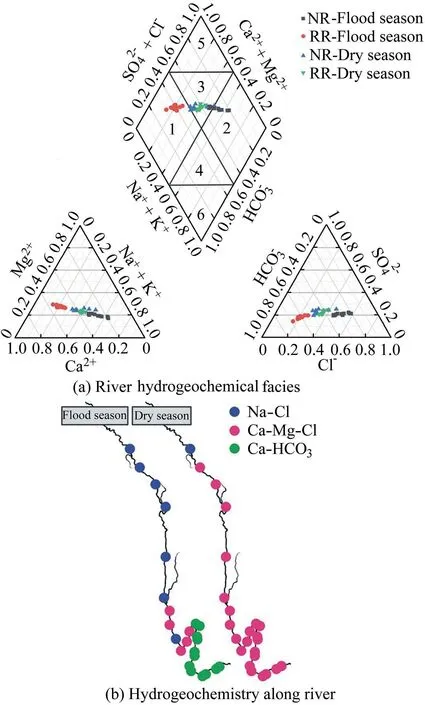
Fig.5.Piper diagram characterizing river hydrogeochemistry in upper natural reaches and lower reservoir-regulated reaches of Jinsha River in flood and dry seasons.
The mechanisms that control river hydrogeochemistry include natural processes (e.g., groundwater leaching,evaporation-crystallization,atmospheric precipitation,and rock weathering)and anthropogenic activities(Gibbs,1970;Martin and Meybeck,1979;Viers et al.,2009).The natural mechanisms can be inferred from the Gibbs diagram and identified by three end-members(Fig.6):(1)precipitation,with aρ(TDS)less than 10 mg/L and aρ(Na+)/[(ρ(Na+)+ρ(Ca2+)]weight ratio of 0.5-1.0;(2)rock weathering,with aρ(TDS)of 70-300 mg/L and aρ(Na+)/[(ρ(Na+)+ρ(Ca2+)]weight ratio of less than 0.5;and(3)evaporation,with aρ(TDS)higher than 300 mg/L and aρ(Na+)/[(ρ(Na+)+ρ(Ca2+)]weight ratio of 0.5-1.0(Gibbs,1970;Qu et al.,2015).In Fig.6,all sampling points were bounded within dotted lines to reveal the mechanisms that control river hydrogeochemistry.
The Gibbs diagram illustrates that evaporation was the major controlling factor of hydrogeochemistry in the upper Jinsha River,and rock weathering became the dominant ionic source in the lower reservoir-regulated reaches in the flood season.By contrast,the evaporation process played a primary role in affecting the hydrogeochemistry of the Jinsha River in the dry season.Generally,the natural ionic sources are mainly derived from bedrocks rather than atmospheric precipitation.The results of the Gibbs plot in this study agreed with previous observations of the Jinsha River and surrounding rivers(Wu et al.,2008;Qu et al.,2015).However,the operation of cascade reservoirs affected river hydrogeochemistry in the lower reaches,especially in the flood season.This is a new finding that has not been reported in previous studies.
3.4.3.Chemical weathering
The ionic equivalent ratios of various hydrogeochemical attributes were used to further determine the way chemical weathering of bedrock affected the hydrogeochemistry of the Jinsha River(supplementary data).The average molar ratio of ρ(Na+)/ρ(Cl-)at the headwaters of the Jinsha River(approximately 1.14)was notably higher than that in marine water(supplementary data;Meybeck,2003).This demonstrates that the ionic contributions of precipitation are negligible in rivers within arid and semiarid alpine regions(Singh et al.,2014).The dissolved load in the headwaters mainly came from the dissolution of ClR,CaR,and QFD,which were intercalated with volcanic rocks and evaporites(e.g.,halite,soft sulphate minerals,and sulfide oxidation).
In the flood season,the notably elevated average molar ratios of[ρ(Ca2+)+ρ(Mg2+)]/[ρ(Na+)+ρ(K+)]and ρ(HCO-3)/[ρ(Na+)+ρ(K+)]were approximately 4.04 and 3.13,respectively.This finding confirmed that the lower reservoir-regulated reaches were dominated by the weathering of ClR,CaR,and HMR minerals(supplementary data;Qu et al.,2019).In addition,the proton-producing reaction is essential for carbonate weathering,including sulfide oxidation and carbonation.The relative importance of these two actions can be explained by theρ(HCO-3)/[ρ(SO2-4)+ρ(HCO-3)]ratio(C ratio)(Pant et al.,2018).The mean C ratio of the lower Jinsha River(approximately 0.77)was significantly higher than 0.5(supplementary data),indicating the vital role of CO2dissolution and carbonate in proton-producing processes,as reported in previous studies(Qu et al.,2019;Fearnside and Pueyo,2012).Furthermore,the increased ratio ofρ(Ca2+)/along the Jinsha River confirmed the predominant function of carbonate weathering as discussed elsewhere(Singh et al.,2014).
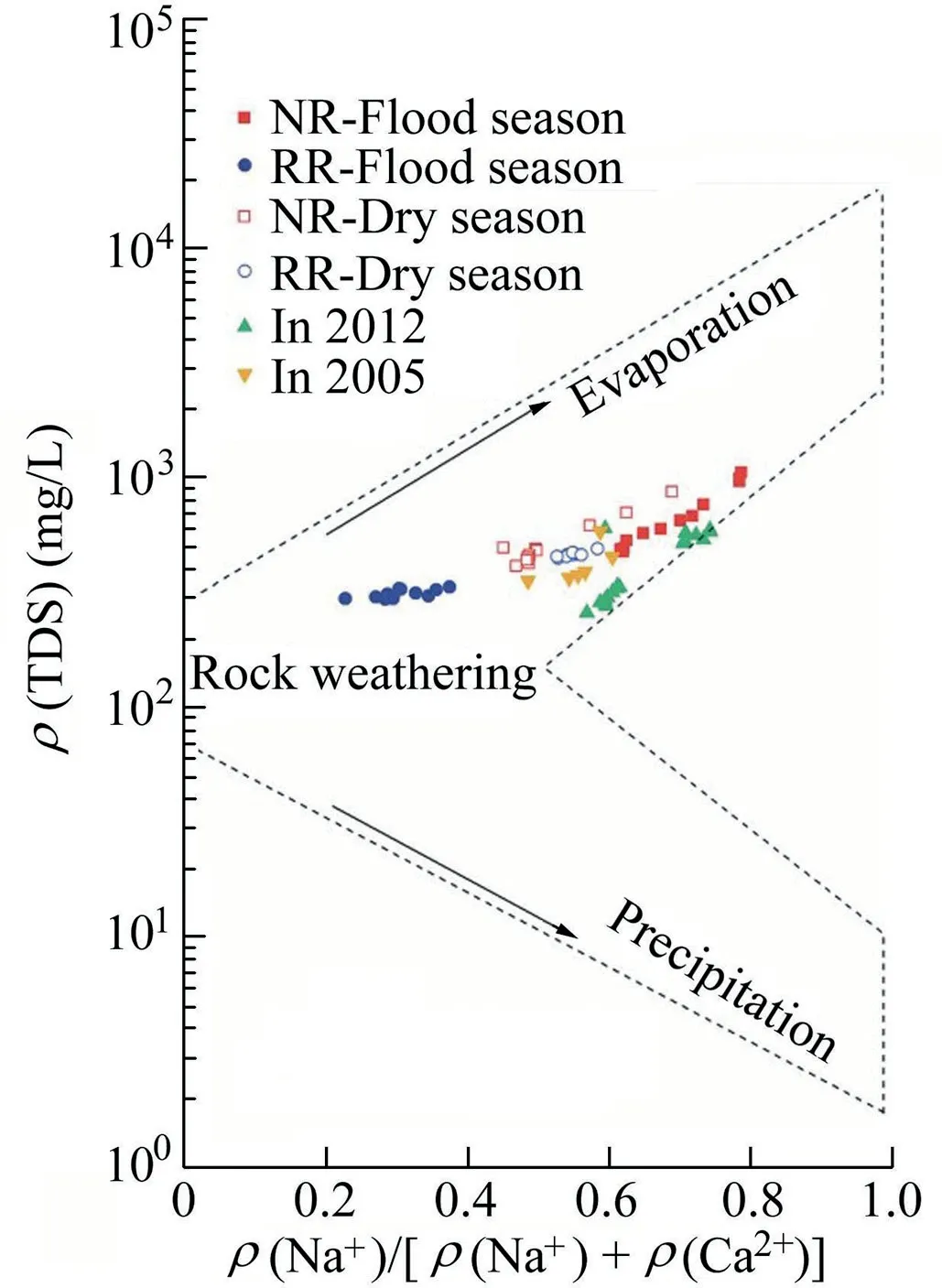
Fig.6.Spatiotemporal variations ofρ(Na+)/[(ρ(Na+)+ρ(Ca2+)]as function ofρ(TDS)in Gibbs graph(Gibbs,1970)from natural and regulated reaches of Jinsha River in flood and dry seasons(data in 2005 and 2012 are from Wu et al.(2008)and Qu et al.(2015),respectively).
All these results demonstrated that the impoundment of cascade reservoirs notably altered the hydrogeochemical composition of the water in the lower Jinsha River,especially in the flood season.The river flow supplied from the upper reaches and supplemented by surrounding tributaries converged and was partially trapped within the reservoirs.This effect altered the proportions of water sources and caused the lower Jinsha River water to be more significantly affected by the process of carbonate weathering than evaporation.
3.5.Environmental implication:Water quality for drinking and irrigation
The Jinsha River is an important water source for the Yangtze River and plays a key role in sustaining downstream human livelihoods and maintaining ecological equilibrium(Li et al.,2013).Furthermore,agriculture,a significant income source in southwestern China,is directly affected by the water quality of regional precipitation and rivers(Thomas et al.,2014).In the Jinsha River Basin,there are many economic crops,such as flue-cured tobacco,as well as various fruits,such as mango,banana,pomegranate,and loquat(Zhang et al.,2006).Thus,a comprehensive evaluation of drinking and irrigation water quality is necessary.
The drinking water quality of the Jinsha River basically fell within the safety thresholds of the WHO guidelines(WHO,2011).However,a few samples exceeded the maximum permissible limits,including sample N1 with regard toρ(TDS)and samples N1,N2,and N3 with regard toρ(Na+)andρ(Cl-)(Fig.3).Due to the dissolution of evaporites and groundwater transport from surrounding springs and saline lakes at the headwaters,all the water samples exceeding the WHO guidelines were collected from the upper arid and semiarid alpine reaches in the flood season.These results are consistent with the observations of other rivers on the Qinghai-Tibet Plateau(Qu et al.,2019).Water quality from the lower reservoir-regulated reaches was well within the WHO guidelines,although the construction of reservoirs had a significant influence on the ionic compositions.
Water quality for agricultural irrigation depends on the type and concentration of dissolved salts,particularly sodium(Na+)(Thomas et al.,2014).Elevated concentrations of Na+in irrigation water may lead to the displacement of Ca2+and Mg2+,thereby reducing soil permeability.Ultimately,crop yield is impacted,leading to calcium deficiency,deflocculation,and tilth impairment.Therefore,two important indices,P and R,were used to assess the irrigation water quality(Thomas et al.,2014).The calculated values and categories of P and R are presented in Fig.7 and supplementary data.Except for a few samples in the upper arid and semiarid alpine reaches of the Jinsha River,the overall water quality was safe for agricultural irrigation.The P and R values were higher in the upstream region due to the impacts of evaporite dissolution,especially in the flood season.Moreover,after the construction of cascade reservoirs,the P and R values in the lower reaches tended to decrease in the flood season and increase in the dry season(Fig.7).Obviously,the operation of cascade reservoirs reduced the water flow in the Jinsha River in the flood season.The reservoir-trapped water from upper reaches and surrounding tributaries decreased the concentrations of Na+to one third of its original contents,which potentially improved the water quality for agricultural irrigation.
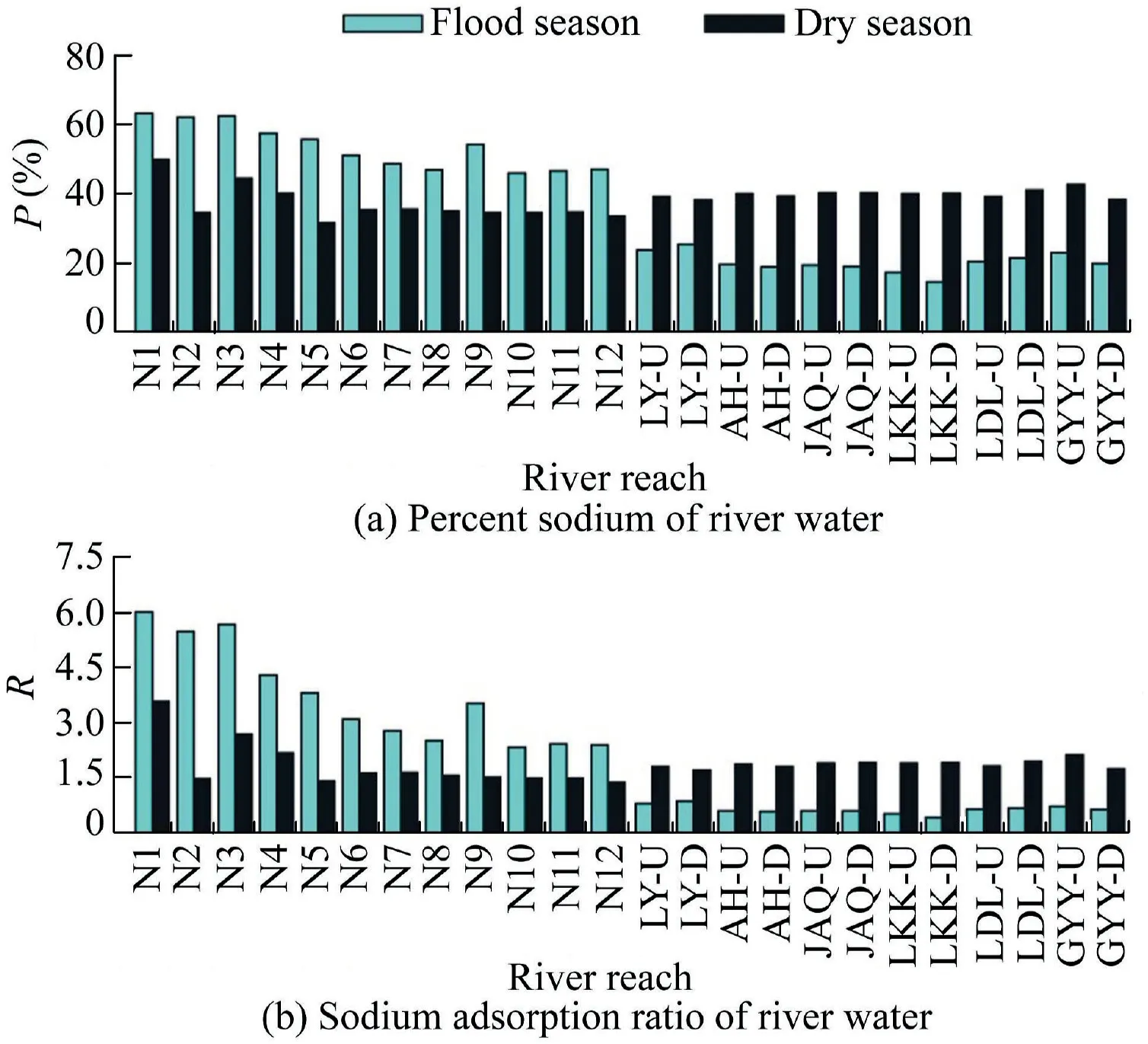
Fig.7.Irrigation water quality assessments through P and R in flood and dry seasons along Jinsha River.
In addition to the influence of cascade reservoirs on drinking and irrigation water,the alteration of hydrogeochemistry in the Jinsha River may also affect zooplankton,phytoplankton,and other biological communities(Chen et al.,2020).The present study provided fundamental knowledge for further investigations into the ecological and environmental impacts of cascade reservoirs.
4.Conclusions
This study provided an integrated understanding on the influence of cascade reservoirs on the hydrogeochemistry of the Jinsha River.The impoundment of cascade reservoirs affected the hydrodynamic conditions.The river flow in the flood season was reduced by approximately 24.5%.It altered the proportions of water sources and caused notable hydrogeochemical alterations in reservoir-regulated reaches.The concentrations of Na+and Cl-were diluted to one third of their original contents,whereas the increased concentration of HCO-3was attributed to the effects of surface runoff from the CaR-dominated lithology.In contrast to that of individual reservoirs,the cumulative influence of cascade reservoirs on river flow regime did not cause abrupt hydrogeochemical changes between the upstream and downstream areas of each reservoir.The reservoir-trapped water from upper reaches and surrounding tributaries decreased the concentrations of Na+,potentially improving the downstream irrigation water quality in the flood season.All these findings provide important implications for further water environment management of cascade reservoirs in large rivers.
Declaration of competing interest
The authors declare no conflicts of interest.
Appendix A.Supplementary data
Supplementary data to this article can be found online at https://doi.org/10.1016/j.wse.2021.06.008.
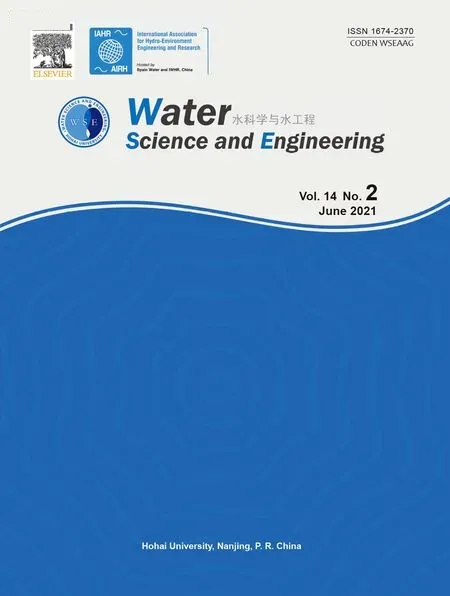 Water Science and Engineering2021年2期
Water Science and Engineering2021年2期
- Water Science and Engineering的其它文章
- Prediction of boundary shear stress distribution in straight open channels using velocity distribution
- Estimation of unloading relaxation depth of Baihetan Arch Dam foundation using long-short term memory network
- Assessment of physicochemical properties of water and their seasonal variation in an urban river in Bangladesh
- Enhancement of removal efficiency of heavy metal ions by polyaniline deposition on electrospun polyacrylonitrile membranes
- Photodegradation of reactive blue 19 dye using magnetic nanophotocatalyst α-Fe2O3/WO3:A comparison study ofα-Fe2O3/WO3 and WO3/NaOH
- Preparation and characterization of Fe2O3/Bi2WO6 composite and photocatalytic degradation mechanism of microcystin-LR
